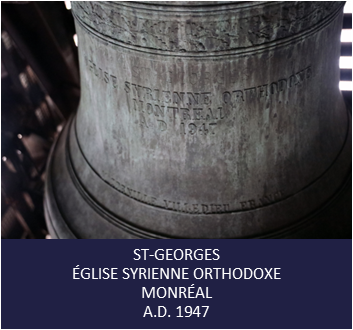CHURCH BELLS

Bells are one of the most essential elements of an Orthodox church. The use of bells is symbolic of the proclamation of the Gospel throughout the world. Bells are used for a number of purposes throughout the liturgical cycle, such as summoning the faithful to services; expressing the triumphal joy of the Church; announcing important moments both to those in church and to those who are not able to be physically present in the church, so that all may be united in prayer; strengthening the Christians in piety and faith, and proclaiming important events (the death of a member of the church; the arrival of the bishop, etc.). Russian Orthodox bell ringing has a history starting from the baptism of Rus in 988 and plays an important role in the traditions of the Russian Orthodox Church. As for the Greek tradition, some sources suggest that the first BELLS were introduced to Constantinople at the emperor’s request by a shipment from the Doge of Venice around 865. These BELLS were hung in a tower near Hagia Sophia. Prior to the use of church BELLS, Greek monasteries would ring the semantron (a flat metal plate) to announce services. The use of BELLS is not only practical, but is also considered to be spiritual. BELLS are sometimes referred to as “singing icons,” because they establish the acoustic space of an Orthodox Church just as icons and hymnography define its visual space, respectively. Icons are considered “scripture in image” as BELLS are “scripture in sound.” BELLS are blessed with a ritual containing many of the elements of the Sacraments of Baptism and Chrismation. In Exodus (Ex. 28:33-34) it is mentioned that small gold bells were worn as ornaments on the hem of the robe of the high priest in Jerusalem, as is done today on the robe of the bishops.
LES CLOCHES DE L’ÉGLISE
Les cloches sont l’un des éléments les plus essentiels d’une église orthodoxe. L’utilisation des CLOCHES est symbolique de la proclamation de l’Évangile à travers le monde. Les cloches sont utilisées à plusieurs fins tout au long du cycle liturgique : convoquer les fidèles à des services ; exprimer la joie triomphante de l’Église ; annoncer les moments importants tant à ceux qui sont dans l’église qu’à ceux qui ne peuvent pas y être physiquement présents ; renforcer les chrétiens dans la piété et la foi ; et proclamer des événements importants (le décès d’un membre de l’église, l’arrivée de l’évêque, etc.). La résonance des cloches orthodoxes russes remonte au « baptême de la Rus’ », vers la fin des années 980 et joue un rôle important dans les traditions de l’Église orthodoxe russe. Quant à la tradition grecque, certaines sources suggèrent que les premières CLOCHES sont introduites à Constantinople à la suite de la demande de l’empereur au Doge de Venise, vers 865. Ces CLOCHES sont alors accrochées dans une tour près de Sainte-Sophie. Avant l’utilisation des cloches d’église, les monastères grecs faisaient sonner le sémantron (une plaque métallique plate) pour annoncer les services. L’utilisation des cloches n’est pas seulement pratique, mais également spirituelle. Les cloches sont parfois appelées « icônes chantantes », car elles établissent l’espace acoustique d’une église orthodoxe, tout comme les icônes et l’hymnographie définissent son espace visuel. Les icônes sont considérées comme les « Écritures en images », tandis que les CLOCHES sont les « Écritures en sons ». La cérémonie de bénédiction des cloches comporte une représentation des symboles des sacrements du Baptême et de la Chrismation. Dans Exode (Ex. 28 : 33-34), il est mentionné que des « clochettes d’or » sont mises sur « tout le tour de la bordure de la robe » du Grand prêtre à Jérusalem, comme l’on voit aujourd’hui sur l’habit sacerdotal des évêques.